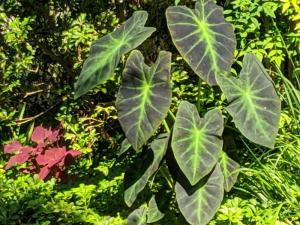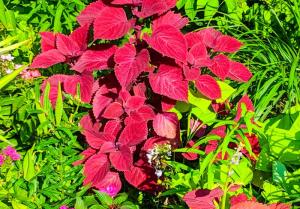Mill Pond Garden invites the public to see the summer season peak blooming of its annual flowers and foliage plants in a garden open day from 10 a.m. to 1 p.m., Sunday, Aug. 2, weather permitting.
For invitation and ticket information, go to www.millpondgrarden.com. Safety rules apply with masks and social distancing.
Mill Pond Garden recognizes the value of annual plants, such as zinnias, that can produce beneficial food and nectar for pollinators, far more than native perennial plants might produce in their short bloom period of a couple weeks. Annuals can be an addition to nature’s biomass and the endangered insect populations. Annual plants certainly add a lot of variety and color to gardens, cheering up everyone more and longer than perennial plants can. In matters of summer color, more is better.
Over the years, Mill Pond Garden has tried many choices of annual plants, and now offers recommendations for some superior choices for Cape Region gardens. Recommended plants are outstanding, reliable performers that fill spaces nicely, and have color compatibility with other perennial and shrub garden flowers.
The colors that coordinate nicely with all others include violet, purple, pale yellow, crimson and white. Other attractive colors like orange and coral can be placed with care so they work with neighboring plants. For best design results, try using many of one or two annual plants and colors to fill the bulk of blank spaces in the garden and give a pleasing united effect instead of a jumbled one. Consider plant size, too, so the annual is not lost among surrounding permanent garden plants. Big is best.
Be sure to give the annual the amount of light it requires, sun or shade, and buy enough to fill a chosen space. Using starter small plants is preferable to ones grown from seed for most annuals, both for the much longer bloom time and avoiding the chore of weeding around seedlings. Direct-sown seedlings are more susceptible to disease when first sprouted, so Mill Pond Garden only buys started plants ready to grow.
When planting an annual out of a container, gently spread the roots out a bit from the bottom and from the sides, and shake some soil off the now-exposed outer roots so they are somewhat bare. Then place the plant in its hole and backfill with improved soil in a good drainage site.
Fertilize annuals when planting with a pinch of Epsom salts and two pinches of organic fertilizer mixed in the planting hole soil. Plant Tone by Espoma, available everywhere, has the best pH. After allowing a few weeks for the plant to get roots and get settled, it may benefit from a one-time, half-strength dose of a balanced chemical salt fertilizer like MiracleGro or Peters for a quicker establishment of plant mass. Avoid repeat applications of such high-potency fertilizer products, which may kill the microbes in the soil around the plant that keep it happy and healthy. Mill Pond Garden does not recommend petroleum-derived chemical fertilizers, all of which are salts and lethal to the soil’s microbiome.
MPG’s favorite annual fertilizer is any balanced organic, with a good mix of nitrogen, phosphorous, potassium, calcium, sulphur, magnesium and trace mineral elements, plus growth hormones (kelp), and spores of beneficial soil microbes. MPG boosts this organic mix by adding a trowel of composted horse manure mixed into the soil in the planting hole for best performance.
Mill Pond Garden’s all-star annual plants include: Benary’s Giant Zinnias, Coleus Red Head and all Sun Coleus, SunPatience Compact Red or Purple, Salvia greggii alba, any Caladium (MPG favorites are pale pinks and White Christmas), Cleome Senorita Rosalita, Taro Elephant Ear, Cordyline Red Star Spike, Acidanthera aka Peacock Orchid, Lobularia Snow Princess and Blushing Princess, Ocimum African Blue Basil, Sweet Potato Vine Sweet Caroline (biggest grower), Petunia Silver Wave, Euphorbia Frosty, Begonia Gryphon and almost any garden Begonias.
There are other annuals MPG likes very much that are tough enough, but they are small and used as accents, including Artemesia Silver Brocade, purple Alternanthera, the yellow-leaved Geranium Persian Queen, and Polka Dot Plant.
For annual vines, some best performers are: Stictocardia beraviensis Hawaiian bell sunset vine, Morning Glory Heavenly Blue, Cardinal Flower, Purple Hyacinth Bean, semihardy Passion Flower Vine, Mandevilla Red Emperor, and a late-blooming beauty, Spanish flag Ipomoea lobata, much loved by hummingbirds and pollinators.
MPG chooses hardy fall and winter annuals like Pansies in yellow, purple and blue for more vigor and productivity; Violas of any color; Redbor Kale and white Peacock Kale, often the only survivor among ornamental cabbages and kales. Annual Chrysanthemums are no longer as hardy as they used to be, and they only bloom a couple of weeks. Mill Pond Garden uses Pansies and Kales for pleasing masses of color all winter long, and all of them bloom and benefit pollinators both in winter and spring. All of the Kales and Pansy flowers are quite edible, too – high in antioxidants, great in salads. All provide sensational good looks over the longest possible time.
The time to make decisions on annuals is now, when they are at their peak, when gardeners can see with their own eyes how well they look and perform in a garden. Then they can be equipped to make a list and plan for next year.
People are turning to their gardens increasingly for the novelty, pleasure, and beauty they can provide when the home environment is the safest place to be. Since annuals are expensive in cost and labor, Mill Pond Garden’s recommended choices are most likely to please, and to give far more value for far less, worth every penny. The joy of seeing happy, beautiful plants uplifts the spirit and mood every day. Spending time walking among plants leads one to love the garden world, enriched with all its amazing creatures.





















































